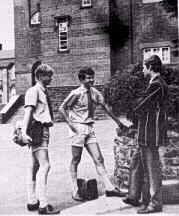
Figure 1.--South African schoolboys in the late 1950s. Note that the boy in the blazer is wearing long pants. |

|
We have begun to collect some information on South African schools, both state and private schools. We are not sure how elementary children dressed for school in the 19th and early 20th centuries. We think that uniforms were generally not required, but have little information. Elementary children at state schools have generally worn shorts since the 1920s, often going barefoot. In the cooler weather, knee socks were worn to school. Many elementary schools currently require uniforms. Often the regulation is short pants in the summer and long pants in the winter. Often a sweater ("jumper") or sweat shirt is worn as part of the uniform. Blazers and ties are rarely required. Many secondary schools followed English dress standards through the 1950s. It was not uncommon for state secondary schoolboys to wear wear caps, ties, blazers, shorts, and knee socks. Private schools both elementary and secondary tended to follow Engish uniform standards and this has continued to the current period. Private schools are much more likely in South Africa to require a formal uniform. There have, however, been some changes over time. Many schools have the boys commonly wear khaki shirts and shorts. I am not sure why khaki has proven so popular in South Africa. Surely it must be related to the khaki worn by the British Army. The Army wore khaki uniforms in the Boer War. No similar war was fought in Australia and New Zealand, so presumably this is the primnary reason that khaki became so popular in South Africa. Other schools may have colored, often blue jumpers (sweaters). Knee socks are commonly worn, often grey kneesocks. We have no information on parochial schools in South Africa.
The basic division is of course primary and secondary schools. We are not sure how primary children dresses for school in the 19th and early 20th centuries. I think that uniforms were generally not required, but have little information. Elementary children at state schools have generally worn shorts since the 1920s, often going barefoot. In the cooler weather, knee socks were worn to school. Many primary schools currently require uniforms. Often the regulation is short pants in the summer and long pants in the winter. Often a sweater ("jumper") or sweat shirt is worn as part of the uniform. Blazers and ties are rarely required. Many secondary schools followed English dress standards through the 1950s. Trends can vary between urban and rural schools. The South African Government promotes uniforms even in rural schools. A good example of a rural school is an unidentified school about 2006. It was not uncommon for state secondary schoolboys to wear wear caps, ties, blazers, shorts, and knee socks. The academically selective grammar school tended to have the strictest dress codes as they often attempted to emulate the ethos of the English public school. This began to change in the 1950s and especially the 1960s. Some state secondary schools dropped uniform requirements all together. Most retained a basic uniform. Currently uniforms continue to be common. Many schools have a summer and winter uniform. Often shorts are worn in the summer term. Some schools require knee socks, but many do not. The styles are currently much more casual than in earlier years. Open neck shirts are most common and ties are now rarely worn.
Private schools both elementary and secondary tended to follow Engish uniform standards and this has continued to the current period. Private schools are much more likely in South Africa to require a formal uniform. There have, however, been some changes over time.
Many schools have the boys commonly wear khaki shirts and shorts. I am not sure why khaki has proven so popular in South Africa. Surely it must be related to the khaki worn by the British Army. The Army wore khaki uniforms in the Boer War. No similar war was fought in Australia and New Zealand, so presumably this is the primnary reason that khaki became so popular in South Africa. Other schools may have colored, often blue jumpers (sweaters). Knee socks are commonly worn, often grey kneesocks.
We have no information on parochial schools in South Africa.
Related Chronolgy Pages in the Boys' Historical Web Site
[Main Chronology Page]
[The 1900s]
[The 1910s]
[The 1920s]
[The 1930s]
[The 1940s]
[The 1950s]
[The 1960s]
[The 1970s]
Navigate the Relate Boys Historical Clothing Style Pages
[Main country page]
[Long pants suits]
[Short pants suits]
[Lederhosen]
[Kneesocks]
[Eton suits]
[Jacket and trousers]
[Blazer
[School sandals]
Navigate the Boys' Historical Clothing School Uniform Pages
[Main South African school page]
[Main School Uniform Page]
[Main National School Uniform Page]
[Australia]
[England]
[France]
[Germany]
[Ireland]
[Italy]
[Japan]
[New Zealand]
[Poland]
[Scotland]
[United States]
Navigate the Boys' Historical Clothing Web Page
[About Us]
[Activities]
[Chronology]
[Clothing styles]
[Countries]
[Debate]
[Economics]
[Garment]
[Gender]
[Hair]
[History]
[Home trends]
[Literary characters]
[School types]
[Significance]
[Transport and travel
[Uniform regulations]
[Year level]
[Other topics]
[Images]
[Links]
[Registration]
[Tools]
[Return to the Historic Boys' School Home]
